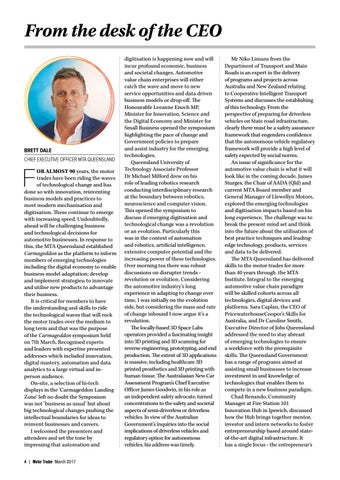From the desk of the CEO
BRETT DALE CHIEF EXECUTIVE OFFICER MTA QUEENSLAND
F
OR ALMOST 90 years, the motor trades have been riding the waves of technological change and has done so with innovation, reinventing business models and practices to meet modern mechanisation and digitisation. These continue to emerge with increasing speed. Undoubtedly, ahead will be challenging business and technological decisions for automotive businesses. In response to this, the MTA Queensland established Carmageddon as the platform to inform members of emerging technologies including the digital economy to enable business model adaptation; develop and implement strategies; to innovate and utilise new products to advantage their business. It is critical for members to have the understanding and skills to ride the technological waves that will rock the motor trades over the medium to long term and that was the purpose of the Carmageddon symposium held on 7th March. Recognised experts and leaders with expertise presented addresses which included innovation, digital mastery, automation and data analytics to a large virtual and inperson audience. On-site, a selection of hi-tech displays in the ‘Carmageddon Landing Zone’ left no doubt the Symposium was not ‘business as usual’ but about big technological changes pushing the intellectual boundaries for ideas to reinvent businesses and careers. I welcomed the presenters and attendees and set the tone by impressing that automation and 4 | Motor Trader March 2017
digitisation is happening now and will incur profound economic, business and societal changes. Automotive value chain enterprises will either catch the wave and move to new service opportunities and data driven business models or drop-off. The Honourable Leeanne Enoch MP, Minister for Innovation, Science and the Digital Economy and Minister for Small Business opened the symposium highlighting the pace of change and Government policies to prepare and assist industry for the emerging technologies. Queensland University of Technology Associate Professor Dr Michael Milford drew on his role of leading robotics research conducting interdisciplinary research at the boundary between robotics, neuroscience and computer vision. This opened the symposium to discuss if emerging digitisation and technological change was a revolution or an evolution. Particularly this was in the context of automation and robotics, artificial intelligence, extensive computer potential and the increasing power of these technologies. Over morning tea there was robust discussions on disrupter trends revolution or evolution. Considering the automotive industry’s long experience in adapting to change over time, I was initially on the evolution side, but considering the mass and rate of change inbound I now argue it’s a revolution. The locally-based 3D Space Labs operators provided a fascinating insight into 3D printing and 3D scanning for reverse engineering, prototyping, and end production. The extent of 3D applications is massive, including healthcare 3D printed prosthetics and 3D printing with human tissue. The Australasian New Car Assessment Program’s Chief Executive Officer James Goodwin, in his role as an independent safety advocate, turned concentrations to the safety and societal aspects of semi-driverless or driverless vehicles. In view of the Australian Government’s inquiries into the social implications of driverless vehicles and regulatory option for autonomous vehicles, his address was timely.
Mr Niko Limans from the Department of Transport and Main Roads is an expert in the delivery of programs and projects across Australia and New Zealand relating to Cooperative Intelligent Transport Systems and discusses the establishing of this technology. From the perspective of preparing for driverless vehicles on State road infrastructure, clearly there must be a safety assurance framework that engenders confidence that the autonomous vehicle regulatory framework will provide a high level of safety expected by social norms. An issue of significance for the automotive value chain is what it will look like in the coming decade. James Sturges, the Chair of AADA (Qld) and current MTA Board member and General Manager of Llewellyn Motors, explored the emerging technologies and digitisation impacts based on his long experience. The challenge was to break the present mind set and think into the future about the utilisation of best practice techniques and leadingedge technology, products, services and data to be delivered. The MTA Queensland has delivered skills to the motor trades for more than 40 years through the MTA Institute. Integral to the emerging automotive value chain paradigm will be skilled cohorts across all technologies, digital devices and platforms. Sara Caplan, the CEO of PricewaterhouseCooper's Skills for Australia, and Dr Caroline Smith, Executive Director of Jobs Queensland addressed the need to stay abreast of emerging technologies to ensure a workforce with the prerequisite skills. The Queensland Government has a range of programs aimed at assisting small businesses to increase investment in and knowledge of technologies that enables them to compete in a new business paradigm. Chad Renando, Community Manager at Fire Station 101 Innovation Hub in Ipswich, discussed how the Hub brings together mentor, investor and intern networks to foster entrepreneurship based around stateof-the-art digital infrastructure. It has a single focus - the entrepreneur’s
